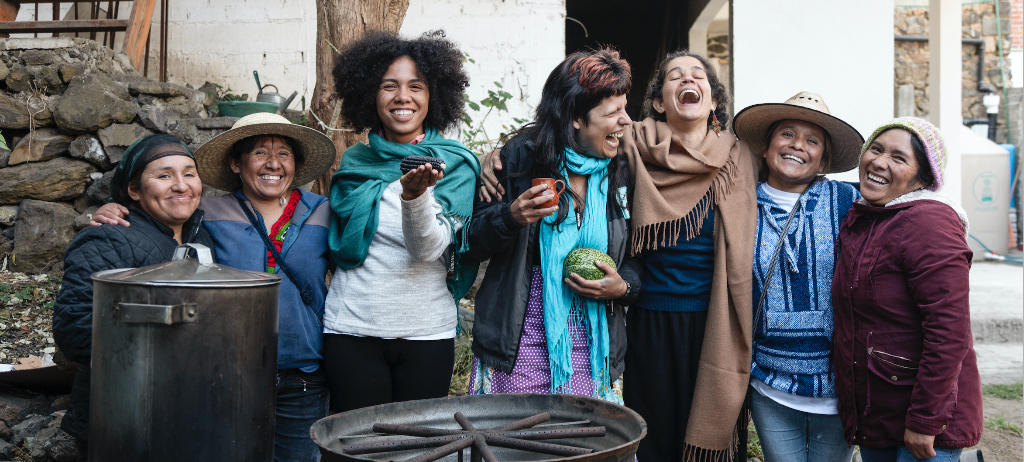
Pictured here: Brazilian students Nane Vieitas and Thais Chilinque and Hemispheric Encounters postdoctoral fellow Juma Pariri of the Indigenous women's collective Mujeres de la Tierra participate in a workshop led by the community kitchen project as part of the Visualizing Foodways Field School.
Visualizing Foodways: Field School Offers Hemispheric Perspectives
By Elaine Smith
Mexico City served as a home base in Feb. 2023 for the Visualizing Foodways Field School – a weeklong exploration of the ways that artists can partner with activists to further food justice and sustainable food systems.
Ten graduate students and post-doctoral fellows from across the Americas were invited to participate in the field school to learn how different parts of the hemisphere can become more connected through questions about food justice. Site visits, meals, workshops, lectures, performances, and artist talks allowed the students, professors, and other participating artists and activists to explore how the arts can help individuals imagine and work to achieve food security, sovereignty, and justice.
Visualizing Foodways grew out of a seven-year Social Sciences and Humanities Research Council partnership grant titled Hemispheric Encounters. It was awarded to Laura Levin, associate professor and director of the Sensorium organized research unit in York University’s School of Arts, Media, Performance and Design (AMPD). Zoë Heyn-Jones, Levin’s former PhD student and post-doctoral fellow at York, curated the field school as part of her work as a Hemispheric Encounters Network (HEN) collaborator, with the Centre for Sustainable Curating at Western University. Heyn-Jones worked with Levin, Tracy Tidgwell a Hemispheric Encounters Network Project Manager and Producer and York PhD student Hurmat Ain to co-produce the event.
“The field school was an experiential learning opportunity for doctoral and post-doctoral researchers,” said Levin. “It supported the research students are undertaking at their home institutions and served as a site for research exchange.”
For example, the group was offered a workshop from Cocina CoLaboratorio (CoLaboratory Kitchen) focussed on growing food on a chinampa (a floating island built on freshwater swampland), which is a Mesoamerican agricultural technique. They visited a chinampa garden, made salad together and engaged in collective creative storytelling about their own connection to food and place.
“This was an opportunity to see farming as a creative action for re-engaging with Indigenous and situated ways of knowing and sustaining community,” said Levin. “It was a way of trying to understand the action of sitting down to a meal as a creative space where community knowledge can be shared.”
“Collaborative, local acts of growing and making food are also an example of resistance to industrial food systems that discourage people from approaching their food in an intentional way and rely on external sources for production and transport. There is a growing movement in both agriculture and cooking to imagine the future of food differently.”
The artists visited by the group included Sofía Olascoaga, a Mexican curator who sees assembling in the kitchen as a creative practice -- gathering as performance -- that allows people to envision new ways of building relations and engaging in political dialogue.
A professional photographer documented the field school experiences and Levin is working with the Hemispheric Encounters Network to create a digital resource to share acquired knowledge with a wider audience. Learn more about this project and enjoy the illustrative photographs.

















